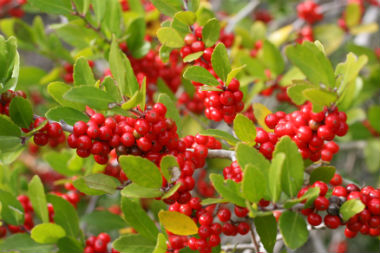 Yaupon Holly. Photo: Sam Bland |
Overnight, temperatures plummeted. Although clear skies prevailed this morning, the bone-aching cold had me scrambling to slip on gloves and a toboggan as I set out along an unmarked trail off the side of N.C. in Cape Hatteras National Seashore. The sun was just beginning to climb above the ocean. Its warm pinkish glow bathed the island in strips of light that shone through the breaks in the dunes. A small family of tundra swans whistled by overhead making their way toward Bodie Island Lighthouse. Salt marsh crept into both sides of the trail in spots, and the high tide had pushed Pamlico Sound up and over the little berm that I followed deeper into the shrub thicket.
After a few minutes of half hiking, half sloshing through the water, the purpose of my rousing from a perfectly warm bed so early in the morning began to materialize. In a wintery landscape dominated by the muted tones of browns and grays that characterize this season on the barrier islands, a dense stand of yaupon holly heavily laden with vibrantly colored berries is an explosion of color that is almost hypnotic. Fire engine red berries contrast against the deep jungle green of the elliptically shaped leaves of this coastal holly. Cedar waxwings the colors of a rainbow flutter in and out, gorging themselves on this winter smorgasbord. A true visual feast in the monochromatic world of winter.
Supporter Spotlight
Sprawled out before me along both sides of the trail, these dense stands of yaupon holly hold a fascinating story of life along the coastal plain. Today, most North Carolinians only know this plant for its use in landscaping. However, there was a time when this unsuspecting shrub was the basis for extensive trade networks between Native American tribes that stretched from the Outer Banks to the Appalachian Mountains. Archeological digs as far west as the Cahokia Mounds in Illinois have even turned up pottery coated with the residue of this plant.
Yaupon holly, pronounced YO-pawn, grows natively along the coastal plain of North Carolina down to the middle of Florida and west along the Gulf Coast. Like the trade networks across the Carolinas suggest, the products of this shrub, despite their geographical restriction to coastal areas, were in high demand throughout the eastern half of the continent.
Traditionally, the green leaves of this plant were used as sort of a native tea known as “asi,” or “cassina,” and by the colonists as “Black Drink.” The red berries of the holly, however, are poisonous. At first glance you might wonder why a simple “tea” might have been traded from the Outer Banks to points as far west as Illinois. With all of the plants out there that held some sort of ethno-botanical use, what was so special about this species of holly? As it turns out, yaupon contains a drug that today drives a multi-billion dollar industry in the United States. You see, pre-colonial America was not that much different than modern day America in that they just couldn’t get enough of the drug we call caffeine.
 A cedar waxwing with a plump, red yaupon holly berry in its beak. Photo: Audubon, Laure W. Neish/VIREO |
Yaupon holly happens to have the unique distinction of being the only plant native to North America that contains caffeine, maybe the world’s most sought-after drug. And much like us coffee addicts today, native tribes would go to great lengths and pay a great expense to appease their addiction. Both John Lawson and William Bartram, who were great naturalists and explorers of early America with insight into native life in the Carolinas, wrote extensively about this.
Almost as soon as Europeans arrived on the scene, they were taught by the natives how to brew up a batch of Black Drink by harvesting the yaupon in the early summer when caffeine content was at its peak. Leaves and stems were roasted, cured and prepared exactly like Asian tea to create a piping hot cup of caffeinated goodness. At a time when trade to the colonies was crippled by royal taxes and import duties, this homegrown caffeine infused drink became all the rage up and down among the colonists.
Supporter Spotlight
Word made it out of the colonies and back to Europe about this so called Black Drink pretty quickly. Before long, our native holly was being sold and marketed as South Sea Tea and Carolina Tea throughout Europe. Due to the abundance of the yaupon holly plant in the American colonies, South Sea Tea was easy to come by and therefore inexpensive. Over the years, yaupon holly became associated with the lower classes of Europe who could not afford the expensive Asian teas or coffee that were being imported through the East India Company. By the mid-19thcentury, yaupon fell out of favor in Europe.
Back across the ocean, however, consumption lingered on, especially in hard times. During the Civil War, the yaupon holly processing plants on Hatteras Island kicked into overdrive as they began producing and exporting Carolina Tea to the rest of the Southern colonies while Northern blockades were keeping English exports out. Likewise during the Great Depression and World War II, U.S. consumption once again spiked as tea and coffee became difficult to obtain. After the war, however, yaupon holly was quickly forgotten as America rode upon a wave of wealth thanks to the Marshal Plan and the reconstruction of Europe.
Stubborn. It’s a word often used to describe those who eke out a living along the Outer Banks. When it came to drinking Carolina Tea, the Outer Banks is thought to have been the last holdout. The tea was sold in restaurants along the Banks into the 1970s; Ocracoke Island is the last known location to have served yaupon tea.
Today, modern science has begun to focus on yaupon holly as another possible weapons the fight against cancer. Thus far, yaupon holly has proven itself to be packed full of antioxidants, beneficial polyphenols and anti-inflammatory properties that show promising results against colon cancer.
Given the abundance of this shrub in our backyards and its health benefits, America just might be ready for a Carolina Tea revival.







